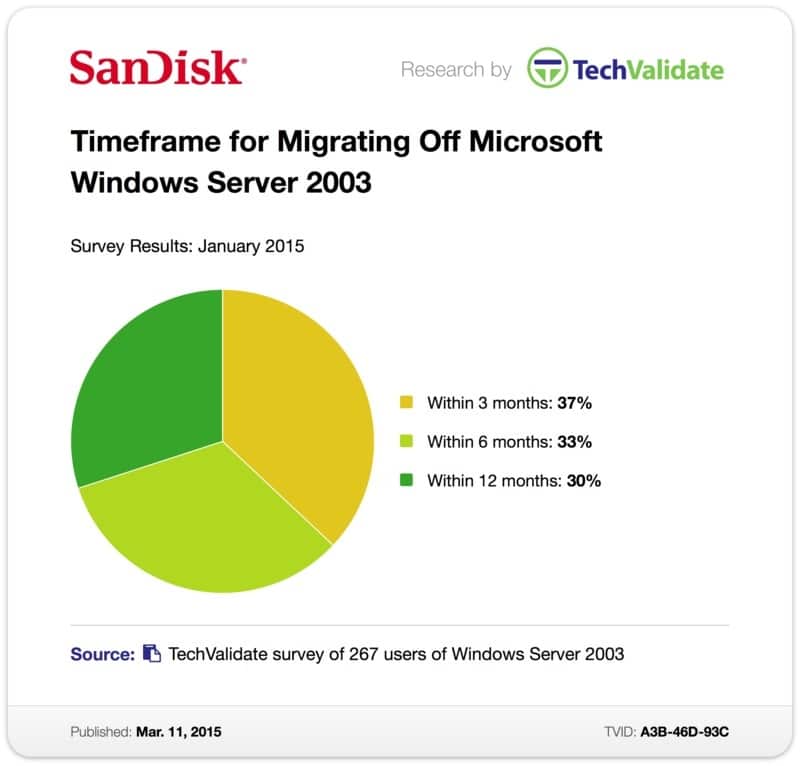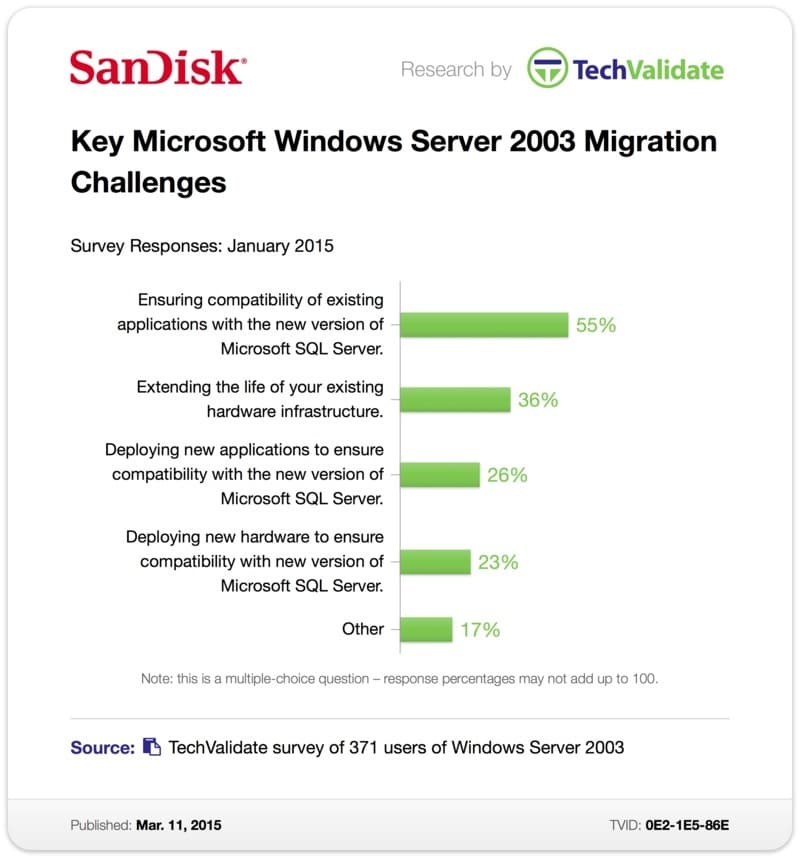Windows Server 2003 EOS – Prepare for a Wave of Modernization
Microsoft’s announcement of an end-of-support (EOS) status for Microsoft Windows 2003/R2 operating system marks the end of an IT era. As of July 14, 2015, Microsoft will no longer issue security updates for any version of Windows Server 2003 (WS03).
There are an estimated 11 million WS03 servers worldwide, and this event has generated a massive wave of infrastructure modernization. In fact, Gartner forecasts that nearly 14% of x86 server shipments since 2014 have been in support of Windows 2003 upgrades.[1] And that wave, is far from over.
At SanDisk® we conducted a sponsored survey in December 2014[2] in which 37% of respondents indicated that they will be migrating their Windows Server in the first quarter of 2015, with another 34% indicating their migration will be in the first half of 2015.
Windows Server 2003 Migration Challenges
Migrating from Windows Server 2003 is not trivial. There are challenges on both the hardware and the software end, specifically around compatibility moving forward. In our survey, organizations outlined the key challenges they face as they prepare to make this transition.
The top three challenges identified were[3]:
- Compatibility of existing applications with new version of SQL Server (55% of respondents)
- Extending the life of existing hardware infrastructure (36% of respondents)
- Deploying new hardware to ensure compatibility with new version of SQL Server (23% of respondents)
Getting More from Your Migration
Any technology refresh should support operational, performance and TCO benefits. Whether your workloads are commercial applications, in-house line-of-business apps, databases, software tools and utilities, or virtualization (desktop/server), your infrastructure should deliver new levels of performance with an ease of scale and reliability. And it should do so in a more cost-effective and flexible environment than your current one.
According to our survey, organizations are looking to implement a modern Windows server operating platform that also provides[4]:
- Improvements in performance and response time (66% of respondents)
- Enhanced scalability (43% of respondents)
- Increased reliability and uptime (40% of respondents)
- Increased security (60% of respondents)
- Better OpEx (power/cooling) (24% of respondents)
- Reduced data center footprint (25% of respondents)
The Flash-Transformed Server Platform
Windows Server 2003 has served its customers well. 10+ years old and it’s still going strong! But, it’s time to modernize.
As we tackle performance, scalability, reliability, costs and footprint, the truth is that legacy systems based on spinning drives simply can’t deliver these new demands. Flash-based SSDs and PCIe solutions are displacing hard drives at a rapid rate in the data center and if you’re transitioning your infrastructure to support WS03 EOS, it’s time to evaluate flash.
We all know that flash is fast. Performance gains are well documented and understood (you can learn more about the benefits of flash in our resource library) – but the story is so much more than performance. Using flash memory solutions to store active data allows companies to greatly consolidate and simplify IT systems. Flash delivers powerful application performance on fewer servers, less storage, and with fewer software licenses. That means organizations experience reduced total acquisition and ownership costs, coupled with unparalleled performance, that drive measurable business benefits and outcomes.
So if you haven’t moved yet, it’s time. Let SanDisk help you maximize your transition to a modern server platform and ensure your platform is optimized, efficient and cost-effective. Migrating away from Windows Server 2003 is an investment in your organization’s futures. Take the next step to transform your data center.
Learn more about Maximizing Your Migration from Windows Server 2003 by reviewing our White Paper
Look for additional blog posts in the coming weeks on how SanDisk can help you maximize your Windows 2003 migration by incorporating a flash-transformed server platform.
[1] Gartner, “Forecast Analysis: Servers, Worldwide, 3Q14 Update”, Oct 2014
[2] TechValidate survey of 267 users of Windows Server 2003
[3] TechValidate survey of 371 users of Windows Server 2003
[2] TechValidate survey of 373 users of Windows Server 2003






